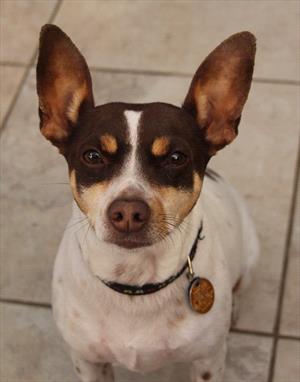Jackson

Photo by Dr. Teri Ann Oursler
Housetraining an adult dog is similar to house training a puppy. With adult dogs, just like with a puppy, you need to supervise them 100 percent of the time they are indoors until the habit of waiting to relieve outside is firmly established. If you have an adult dog not used to holding his bladder or bowels, he will need time to develop bladder and bowel control. The general rule of thumb is that your dog should be accident-free for one month before gradually giving him more freedom around the house.
Supervising 100 percent of the time means that your dog is either in a "safe" area where they can't make a mistake, such as a crate or very small room with a baby-gate, or they are in the room with you and you are watching them at all times. It may help to have them on leash and tie the leash to your belt buckle. When a dog has a housetraining accident, it's not the dog's fault, it means the person failed in supervising.
Confinement of some sort is necessary to keep the dog from making mistakes that will form the wrong housetraining habits. A crate should be big enough for the dog to stand up, lie down, and turn around in a circle. Dogs have a natural instinct to keep their resting area clean. If the crate is too big they will establish separate resting and relief areas. The crate is only to be used when no one can watch your dog.
Since dogs sleep 14 hours a day, a crate is a humane and reasonable way to aid in housetraining most dogs, with the dog merely sleeping most of the time he is in the crate. It is important to introduce the crate slowly with treats to make it a positive experience so that your dog does not panic when you put him in the crate. Baby gates can be effective, but they are not as secure as crates.
It's a great service to a dog to teach him to rest calmly in a crate, even if you only use it for training and then put it away in the closet to save for emergencies. Dogs have to rest in crates when they are in for veterinary care and other situations. If at some future time in his life the dog develops separation anxiety (where dogs may tear up the house, urinate, defecate or vocalize due to feeling stressed), the ability to rest in a crate could save him in his home. And in case of travel and disasters, sometimes the only dogs who are able to stay with their owners are the dogs who can handle being in a crate. It's generally best to teach your dog to be in a crate a little at a time.
When your dog goes outside during the housetraining process you need to go with him every time so you can praise your dog, or better yet give him a tasty treat right when he finishes urinating or defecating. This is a lot of work, but in the process your dog learns what you want and you figure out his schedule because you were there. You also know whether your dog relieved his bowels or bladder or both, and when.
Soon, you know how many times a day your dog needs to do each of those functions. Dogs are not all the same about these needs, and the frequency also changes with age, illness, changes in diet, and changes in schedule - your schedule as well as your dog’s schedule.
Make sure all spots in the house where your dog might have relieved himself have been cleaned in the right manner to tell his keen sense of smell and doggy instincts that the house is not a bathroom. If you don't do this, the scent he can smell - even though you can't smell it - will draw him back to use the spot again. Bacterial enzymatic odor eliminating products will work either on a fresh spot or on a spot that was not treated promptly. Deodorants and disinfectants normally used for cleaning don't remove this special scent. And perhaps the worst thing to use is ammonia. Urine contains ammonia, so this actually signals your dog's nose that this is the spot!
Never punish your dog for a housetraining mistake. He won't understand and the punishment can create new problems. Instead, keep him in the room with you at all times when he is not in his special confinement area. If you see him start to have an accident, just say "Outside" as you rush out the door with him. Your goal is to get him to finish outside so you can praise him. Teach him the word "Outside" for going out there, and "Better Go Now" or some other phrase for actually relieving himself--these words are taught just by saying them at the right times, until he catches on to what they mean. This helps communication, and thus also helps training.
Housetraining a dog of any age requires diligence, commitment, patience, and good-nature from the owner. If the dog makes a mistake when you weren't watching him, oops, that was your mistake, not his. He is just a dog, and has no idea why you are upset when he relieves himself in the house. But most dogs can learn, if you are consistent, and help him avoid mistakes by being there for him.